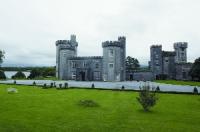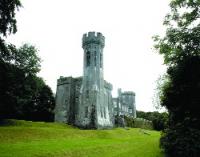Lough Cutra castle, Co. Galway
Published in 18th–19th - Century History, Features, Issue 3 (May/June 2011), Volume 19
The front of Lough Cutra Castle, a series of Gothic towers attached to one another by castellated sections. The tower to the right, at the south-west corner, looks more striking
Designed by the English architect John Nash (1752–1835) for Colonel Charles Vereker, 2nd Viscount Gort, Lough Cutra Castle is located on the banks of Lough Cutra. Nash had many well-known commissions, including the master-plan for the Regency area in London, the Royal Pavilion, Brighton, and the conversion of Buckingham House into Buckingham Palace for King George IV. The original intention was to build an Italian-style house in the southern portion of the demesne, but after a visit by Gort to Nash’s East Cowes Castle on the Isle of Wight a Gothic Revival castle was built instead.
Construction, of limestone blocks, started in 1811 and was not completed until after 1817. Brothers James and George Pain oversaw the construction; they were later to develop their own successful architectural practice and to design such mansions as Dromoland Castle, Co. Clare. The main portion of the building is a series of towers attached to one another by castellated sections. The total cost of the castle and landscaping of the surrounding grounds was said to be £80,000.
After the 2nd viscount’s death in 1842, the castle passed into the hands of his son, John Vereker, 3rd Viscount Gort. In 1851 financial strain, brought on by previous debts and the Great Famine, led to the sale of the castle. The estate lands were divided and sold to separate owners, while the house and grounds were purchased by the Loreto Sisters for use as a convent school. Shortly afterwards Lough Cutra was sold again, this time to Lord Gough. In 1900 the Gough family constructed a Victorian-style addition, demolishing two of the towers.
In 1928 the family moved into converted buildings in the stable yards. The castle remained unoccupied, except for a brief period when it was used to house soldiers during the Emergency, and was finally sold in 1952 to the 7th Viscount Gort, who purchased it for his great-niece, Elizabeth Sidney. By then it was derelict and in 1967 plans were made to restore it. Using the original plans, Lord Gough’s Victorian addition was demolished and restoration was completed in 1970. Elizabeth Sidney’s divorce led to the resale of the property, when it came into its current ownership; since then, restoration has continued.

Lough Cutra Castle from the back. (NIAH)
Where the grounds are concerned, it has been suggested that John Nash’s earlier work with the noted landscape gardener Humphrey Repton in the ‘romantic picturesque’ style influenced his garden design at Lough Cutra Castle, where there are signs of the characteristic interweaving of building and grounds. The grounds were altered from their original form: the castle was placed on a rocky hillside, with soil brought in and turf laid down on the surrounding rock to create the present terraced landscape. Garden designer John Sutherland (1745–1826), whose style is said to reflect that of ‘Capability’ Brown, was hired to create front and back approaches to the castle. Sutherland had already designed gardens at Slane Castle, Co. Meath, and Rockingham, Co. Roscommon, and would go on to work on Mountjoy Square, Dublin, and Caledon House, Co. Tyrone.
The first Lord Gort was responsible for planting trees and shrubs around the property, including replanting the original woodlands. Later the Gough family made further additions, including an azalea walk along the lakeshore and an American Garden south-west of the castle. In the 1970s the lakeside gardens were razed and all that remains of the nineteenth-century landscape are the terraced slopes, several large rhododendrons and specimen trees, a line of yews, and a set of steps that once led to a sunken garden. HI
Amanda Shull is a US International Council on Monuments and Sites (ICOMOS) intern with Galway County Council. Series based on the National Inventory of Architectural Heritage’s ‘building of the month’, www.buildingsofireland.com.
















